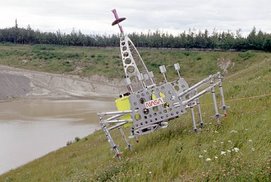At the end of 2006, the School of Mechanical and Manufacturing Engineering at DCU teamed up with nine other European universities, research centres and hospitals from Germany, the UK, Spain, France, Italy and Turkey, to develop a robot swarm system for hospitals. The project, called IWARD (Intelligent Robot Swarm for Attendance, Recognition, Cleaning and Delivery) received a 2.8 million euro funding from the Framework 6 Programme of the European Union for a three year period. The project co-ordinator is Dipl.-Ing. Thomas Schlegel from the Fraunhofer IAO institution in Stuttgart, and the DCU team is lead by Dr. Tamas Szecsi, a senior lecturer at the School of Mechanical and Manufacturing Engineering. Most of the partners, including DCU, are also members of an EU-supported Network of Excellence called I*PROMS (Innovative Production Machines and Systems). The IWARD project is an excellent demonstration of the efforts of the network to integrate the research potential of its members.
Although the hospital robots have been described in the press as ‘robotic nurses’, the definition is slightly misleading because the purpose of these robots is not to replace nurses but to help them so that they can spend more time with patients.
Each robot will contain a mobile, self-navigating platform and several modules attached to it to perform the following major tasks:
1. Guidance and assistance: patients and visitors will be provided information about the location of units and wards in the hospital. They can follow the moving robot to their destination. For example, a patient can be guided to the X-ray room, or a visitor to a patient’s ward. The speed of the robot can be adjusted automatically according to the pace of the person. Guidance between floors and/or buildings can be negotiated between several robots. The built-in information system will also allow to get general information (doctors’ names, locations, timetables, services) of the hospital.
2. Delivery: the robots can deliver medical supplies and other materials to patients lying in bed, and medical documentation (X-rays, patients’ files) to doctors and nurses. Each compartment will be equipped with a security device so that only the appropriate persons will have access to them. Authorised access to the content of the compartments will be guaranteed through face and voice recognition.
3. Cleaning: a floor cleaning device, attached to the robot base, will perform continuous cleaning while the robot is moving. This will allow to maintain a high level of hygiene in the hospital. It will also facilitate fast clean-up of spillages.
4. Condition monitoring: sensors attached to the robot will give up-to-date information about the conditions in the hospital (temperature, humidity). The camera system, coupled with image recognition software, can detect unusual situations (patients lying on the floor, objects obstructing corridors). It is also possible to obtain information about the patients’ condition (like body temperature) using remote measurements. The camera-equipped robot can also deliver compressed pictures and video information of patients that can be used to evaluate their condition. This could especially be useful during the night when supervision level is normally limited. The data can also be fed to the information management and retrieval system that would enable the collection of anonymous information about patients’ habits.
5. Surveillance: the moving robots, equipped with a camera and microphone gives an ideal opportunity to provide information for the security system of the hospital. Face recognition and person-tracking systems will be used to improve the hospital security. Areas that can not be reached by the robots will be monitored by stationary cameras. The system can also facilitate to obtain information about patients’ whereabouts.
In order to minimise the cost of such a system and to make it affordable to hospitals, the robot swarm will heavily rely on low-cost standard components and plug-and-play sensors. As opposed to the large individual robots that are currently available in some hospitals, the robot swarm will be based on smaller robots. This should cause less interference with persons and objects in the hospital. Using a quick-fix mechanism, any modules and sensors can easily be mounted on the base at any time.
Users will be able to communicate with the robot system through a specially designed human-robot interface that includes speech, voice and face recognition. In order to maintain a safe interaction between humans and robots, all robots will be equipped with safety devices. The users are not expected to programme the robots; they will only give them high-level, task-oriented commands. Access authorisation will be managed by the robot software.
The mobile robot platform will be able to perform self-navigation in the hospital using vision sensors and a detailed hospital model. The self-learning capabilities of the robots will enable quick and reliable adaptation to a changing environment.
There will be no central computer in the system. Instead, the robots will be equipped with a level of intelligence to negotiate and schedule tasks between themselves dynamically; the robot swarm is a self-organising system. The robots themselves decide which of them is most suitable to perform a given task at a given time. There will be wireless communication between the robots. The interchangeable robot modules can be attached to the robot bases based on demand. Artificial intelligence learning mechanisms will support all robot functions.
The main task of the DCU team is to develop the robot modules that will be attached to the mobile robot base. Each module will be a stand-alone, self-contained unit. Researchers at the other partner institutions will develop the robot base and its control system, the human-robot interface, the software platform and the swarm application software.
The prototype of the system, containing several robots and a realistic hospital model, should be developed by the end of 2009. It will first be analysed in a laboratory set-up, after which it can be tested in real hospital environment. It is hoped that this robot swarm system will contribute to better patient care in hospitals.
More information can be found on the web page of the project at
IWARD.
















